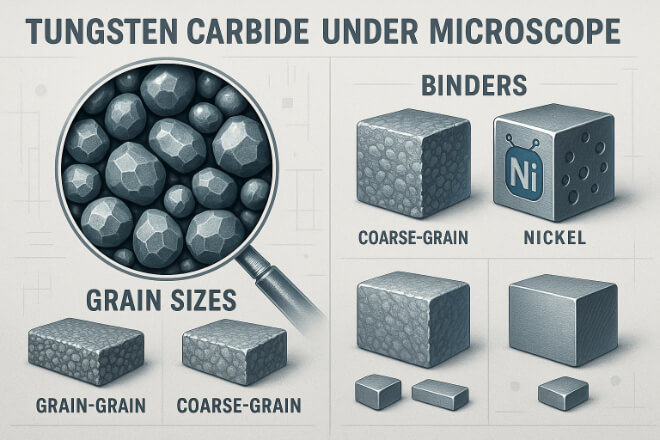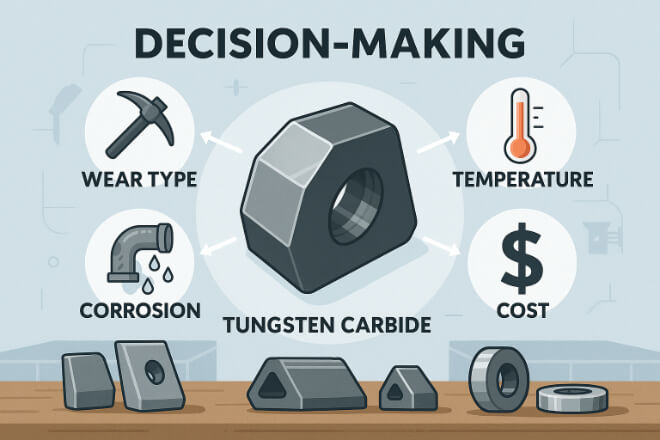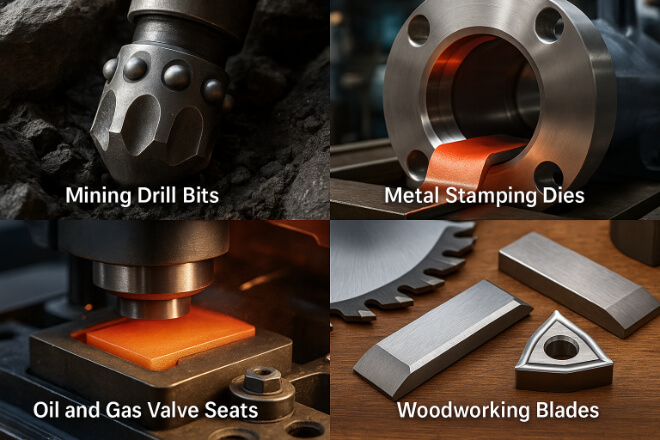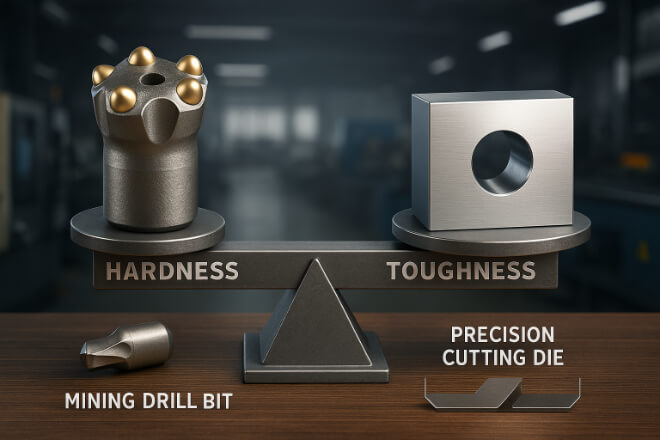أجزاء تآكل كربيد التنغستن تُستخدم في الصناعات التي تتعرض فيها الأدوات للتآكل الشديد أو الحرارة أو الصدمات. ولكن ليست جميع أنواع كربيد التنغستن متشابهة.
تُصنع درجات مختلفة للتعامل مع ظروف عمل مختلفة. قد يؤدي اختيار الدرجة الخاطئة إلى تعطل مبكر، وارتفاع التكاليف، وتوقف العمل. يضمن اختيار الدرجة المناسبة أقصى عمر افتراضي للأداة وأدائها.
في هذا الدليل، نشرح ما تعنيه الدرجات، وكيف تختلف، وكيفية اختيار الدرجة المناسبة لتطبيقك.
الهدف هو جعل هذه العملية بسيطة وواضحة، خاصة لصناع القرار في مجال التصنيع، التعدين, النفط والغازوتشكيل المعادن وغيرها من الصناعات الثقيلة.
فهم درجات كربيد التنغستن

تعتبر درجة كربيد التنغستن مزيجًا من شيئين رئيسيين:
حجم الحبوب من جزيئات الكربيد
نوع المادة الرابطة ونسبتها (عادةً الكوبالت أو النيكل)
مزيج مختلف يغير صلابة, صلابة، و مقاومة التآكل من الجزء.
أنواع كربيد التنغستن الشائعة واستخداماتها
| نوع الدرجة | الخصائص الرئيسية | الأفضل لـ |
|---|---|---|
| كربيد ذو حبيبات دقيقة | صلابة عالية، مقاومة ممتازة للتآكل | أدوات القطع الدقيقة، والقوالب، والفوهات المقاومة للتآكل |
| كربيد حبيبات خشنة | صلابة أعلى ومقاومة للصدمات | أدوات التعدين، رؤوس الحفر، أجزاء التآكل الثقيلة |
| كربيد دون الميكرون | صلابة شديدة، لمسة نهائية ناعمة | الأدوات الطبية، والتصنيع الدقيق، والأجزاء الدقيقة |
| كربيد مرتبط بالنيكل | مقاومة التآكل | صمامات النفط والغاز، والمضخات الكيميائية، والتطبيقات البحرية |
العوامل التي يجب مراعاتها عند اختيار الدرجة

عند اختيار درجة كربيد التنغستن، ينبغي على صناع القرار النظر إلى:
نوع التآكل - هل هو تآكل كاشط، أو تآكل ناتج عن الصدمات، أو مزيج منهما؟
درجة حرارة التشغيل - بعض المواد الرابطة تعمل بشكل أفضل عند درجات الحرارة العالية.
خطر التآكل - إذا كان الجزء موجودًا في بيئة كيميائية أو رطبة، فإن الدرجات المرتبطة بالنيكل تساعد.
التكلفة مقابل الأداء - قد تكون الدرجة الأعلى أكثر تكلفة ولكنها قد تدوم لفترة أطول.
أمثلة الصناعة

التعدين:كربيد حبيبي خشن لمقاومة الصدمات أثناء الحفر والسحق.
تشكيل المعادن: كربيد ذو حبيبات دقيقة للقوالب واللكمات للتعامل مع التآكل.
النفط والغاز:كربيد مرتبط بالنيكل لمقاعد الصمامات المعرضة للسوائل المسببة للتآكل.
نجارة:كربيد متوسط الحبيبات لتحقيق التوازن بين الحدة والقوة.
نصائح لصناع القرار

العمل مع المورد الذي يمكنه اختبار العينات الخاصة بوظيفتك المحددة.
تتبع أنماط التآكل في الأدوات الموجودة لفهم ما هو الفشل أولاً.
تجنب الإفراط في التحديد - فالدرجة الأكثر تكلفة قد لا تؤدي دائمًا إلى تحسين الأداء.
خاتمة
يعد اختيار الدرجة الصحيحة من كربيد التنغستن بمثابة توازن بين الصلابة والمتانة والاحتياجات البيئية.
من خلال فهم آلية عمل الدرجات، يمكن لصانعي القرار إطالة عمر الأدوات، وتقليل فترات التوقف، وتحسين الكفاءة. فالاختيار الصحيح يوفر المال ويزيد من الموثوقية على المدى الطويل.
إذا كنت تريد معرفة المزيد من التفاصيل حول أي شركة، فلا تتردد في اتصل بنا.

